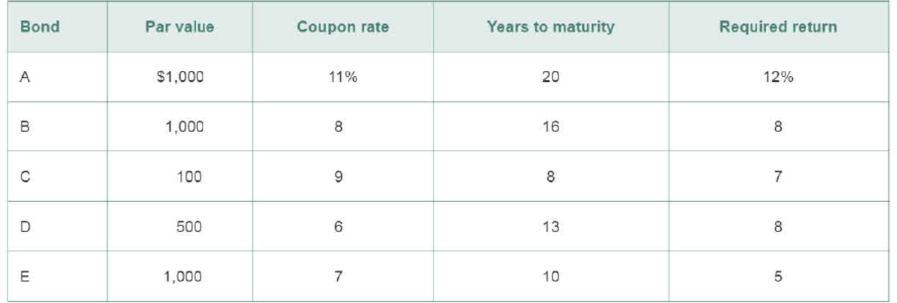
MyLab Finance with Pearson eText -- Access Card -- for Principles of Managerial Finance
15th Edition
ISBN: 9780134479903
Author: Chad J. Zutter, Scott B. Smart
Publisher: PEARSON
expand_more
expand_more
format_list_bulleted
Concept explainers
Textbook Question
Chapter 6, Problem 6.16P

Expert Solution & Answer
Want to see the full answer?
Check out a sample textbook solution
Students have asked these similar questions
The table below shows current and expected future one-year interest rates, as well as current interest rates on multiyear bonds. Use the table to calculate the liquidity premium for each multiyear bond.
Year
One-Year Bond
Rate
Multiyear Bond Rate
1
2.00%
2.00%
2
3.00%
4.00%
3
6.00%
6.00%
4
9.00%
7.00%
5
11.00%
9.00%
Part 2
The liquidity premiums for each year are given as: (Enter your responses rounded to two decimal places.)
The table below shows current and expected future one-year interest rates, as well as current interest
rates on multiyear bonds. Use the table to calculate the liquidity premium for each multiyear bond.
One-Year Bond
Rate
2.00%
3.00%
4.00%
7.00%
10.00%
11 =%
21 =
131
The liquidity premiums for each year are given as: (Enter your responses rounded to two
decimal places.)
141
151
=
=
=
Year
1
2
3
4
5
%
%
%
%
Multiyear Bond Rate
2.00%
3.00%
6.00%
8.00%
11.00%
The table below shows current and expected future one year interest rates, as well as current interest rates on multiyear bonds. Use the table to calculate the liquidity premium for each multiyear bond. Year One - Year Bond Rate Multiyear Bond Rate 12.00% 2.00% 23.00% 5.00% 34.00% 8.00% 46.00% 11.00% 59.00% 12.00% Part 2 The liquidity premiums for each year are given as: (Enter your responses rounded to two decimal places.)
Chapter 6 Solutions
MyLab Finance with Pearson eText -- Access Card -- for Principles of Managerial Finance
Ch. 6.1 - What is the real rate of interest? Differentiate...Ch. 6.1 - What is the term structure of interest rates, and...Ch. 6.1 - For a given class of similar-risk securities, what...Ch. 6.1 - Prob. 6.4RQCh. 6.1 - List and briefly describe the potential issuer-...Ch. 6.2 - What are typical maturities, denominations, and...Ch. 6.2 - Differentiate between standard debt provisions and...Ch. 6.2 - How is the cost of bond financing typically...Ch. 6.2 - Prob. 6.9RQCh. 6.2 - Prob. 6.10RQ
Ch. 6.2 - Compare the basic characteristics of Eurobonds and...Ch. 6.3 - Why is it important for financial managers to...Ch. 6.3 - Prob. 6.13RQCh. 6.3 - Prob. 6.14RQCh. 6.3 - Prob. 6.15RQCh. 6.4 - Prob. 6.16RQCh. 6.4 - What relationship between the required return and...Ch. 6.4 - If the required return on a bond differs from its...Ch. 6.4 - As a risk-averse investor, would you prefer bonds...Ch. 6.4 - What is a bonds yield to maturity (YTM)? Briefly...Ch. 6 - Learning Goals 5, 6 ST6- 1 Bond valuation Lahey...Ch. 6 - Learning Goal 1 E6-1 The nominal, risk-free rate...Ch. 6 - The yields for Treasuries with differing...Ch. 6 - The YTMs for Treasuries with differing maturities...Ch. 6 - Assume that the rate of inflation expected over...Ch. 6 - Calculate the risk premium for each of the...Ch. 6 - You have two assets and must calculate their...Ch. 6 - Prob. 6.7WUECh. 6 - Assume a 5-year Treasury bond has a coupon rate of...Ch. 6 - Interest rate fundamentals: The real rate of...Ch. 6 - Prob. 6.2PCh. 6 - Prob. 6.3PCh. 6 - Yield curve A firm wishing to evaluate interest...Ch. 6 - Term structure of interest rates The following...Ch. 6 - Bond interest payments before and after taxes...Ch. 6 - Prob. 6.11PCh. 6 - Prob. 6.13PCh. 6 - Prob. 6.14PCh. 6 - Bond valuation: Annual interest Calculate the...Ch. 6 - Prob. 6.20PCh. 6 - Bond valuation: Semiannual interest Find the value...
Knowledge Booster
Learn more about
Need a deep-dive on the concept behind this application? Look no further. Learn more about this topic, finance and related others by exploring similar questions and additional content below.Similar questions
- A company issued bonds with a $100,000 face value, a 5-year term, a stated rate of 6%, and a market rate of 7%. Interest is paid annually. What is the amount of interest the bondholders will receive at the end of the year?arrow_forwardBOND PRICING #2 for Borrowing Money Inc Borrowing Money Inc (BMI) issues a bond on January 1, 2021 with a face valuc of $400,000. The bond has an 7 year maturity date and requires SEMI ANNUAL interest paymerits. The bond's stated interest rate is 3% and the current market interest rate is 2%. Hint: remember to set your expectations PV tables will be needed. Do not round your PVIF, but you may round answers to whole dollars. Prepare the journal entry (in proper form) at issuance of this bond for BMI. Include your journal for grading on your PDF upload. Your multiple step calculations must also be shown To get a preliminary idea of how you did you may enter your calculated amount for cash received at Issuancearrow_forwardHow do I Prepare a journal entry for a bond to record the installment payment and any interest. with an effective interest rate for the bond is 14% per year? Is this the correct way below? Credit Cash Debit Mortgage payable Debit Interest Payable Credit Casharrow_forward
- Calculate the selling price of the following 5-year bond issue: e. # bonds Bond rate of interest Interest payable Market rate of interest Bond maturity (face) value 600 5.8% semi-annually 6.0% $1,000arrow_forwardThe balance in Discount on Bonds Payable that is applicable to bonds due in three years would be reported on the balance sheet in the section entitled a.current assets b.intangible assets c.long-term liabilities d.investmentsarrow_forward. Which of the following are true for a bond maturing on a single date when the effective interest method of amortizing bond discount is used?a. interest expense as a percentage of the bond’s carrying amount varies from period to periodb. interest expense increases each six-month period c. interest expense remains constant each six-month periodd. effective interest rate is used to compute for the periodic interest a and b c and d a and d b and carrow_forward
- Enumerate the following; 32. Provides for recognition of an equal amount of premium or discount amortization each period. 33. Bonds that mature in one lump sum at a specified future date. 34. Bonds that provide for conversion into some other security at the option of the stockholder. 35. Bonds that mature in a series of installments at future dates. 36. The difference between the face value and the sales price when bonds are sold below their face value. 37. Bonds for which assets are pledged to guarantee repayment. 38. Obligations that are not expected to be paid in cash within one year or the normal operating cycle. 39. Bonds that do not bear interest but instead are sold at significant discounts providing the investor with a total interest payoff at maturity. 40. Costs incurred by the issuer for legal services, printing and engraving, taxes, and underwriting in connection with the sale of a…arrow_forwardDetermine the present value of 10 year bonds payable with face value of $86,000 and stated interest rate of 14% paid semiannually. The market rate is 14% at issurance.arrow_forwardBonds pay the face value to the investor when they are a. held over 10 years. b. held 20 years. c. held until maturity. d. sold on the market before maturity.arrow_forward
- From page 9-2 of the VLN, how do you determine the annuity cash flow (the bond interest payment) from an annual bond? Group of answer choices A. Bond payable x stated rate B. Bond liability x stated rate C. Bond payable x market rate D. Bond liability x market ratearrow_forwardAssume that a bond will make payments every six months as shown on the following timeline (using six-month periods): The timeline starts at Period 0 and ends at Period 20. The timeline shows a cash flow of $ 20.72 each from Period 1 to Period 19. In Period 20, the cash flow is $ 20.72 plus $ 1,000. Period0121920 Cash Flows$20.72$20.72$20.72$20.72+$1,000 a. What is the maturity of the bond (in years)? b. What is the coupon rate (as a percentage)? c. What is the face value?arrow_forwardYour company issues $3,500,000 bonds at 7% interest with annual interest payments. Bonds have a maturity date in 30 years. At the time of issue, the market rate is 5%. а. Calculate the issue price of the bond. b. Record the journal entry for the issue of the bond С. Record the journal entry for the first interest payment d. How much interest is recorded on the income statement in Year 1? е. Record the journal entry for the final entry at the bond maturity date.arrow_forward
arrow_back_ios
SEE MORE QUESTIONS
arrow_forward_ios
Recommended textbooks for you
- Principles of Accounting Volume 1AccountingISBN:9781947172685Author:OpenStaxPublisher:OpenStax College
 Financial Accounting: The Impact on Decision Make...AccountingISBN:9781305654174Author:Gary A. Porter, Curtis L. NortonPublisher:Cengage Learning
Financial Accounting: The Impact on Decision Make...AccountingISBN:9781305654174Author:Gary A. Porter, Curtis L. NortonPublisher:Cengage Learning Intermediate Accounting: Reporting And AnalysisAccountingISBN:9781337788281Author:James M. Wahlen, Jefferson P. Jones, Donald PagachPublisher:Cengage Learning
Intermediate Accounting: Reporting And AnalysisAccountingISBN:9781337788281Author:James M. Wahlen, Jefferson P. Jones, Donald PagachPublisher:Cengage Learning

Principles of Accounting Volume 1
Accounting
ISBN:9781947172685
Author:OpenStax
Publisher:OpenStax College

Financial Accounting: The Impact on Decision Make...
Accounting
ISBN:9781305654174
Author:Gary A. Porter, Curtis L. Norton
Publisher:Cengage Learning

Intermediate Accounting: Reporting And Analysis
Accounting
ISBN:9781337788281
Author:James M. Wahlen, Jefferson P. Jones, Donald Pagach
Publisher:Cengage Learning
Bond Valuation - A Quick Review; Author: Pat Obi;https://www.youtube.com/watch?v=xDWTPmqcWW4;License: Standard Youtube License